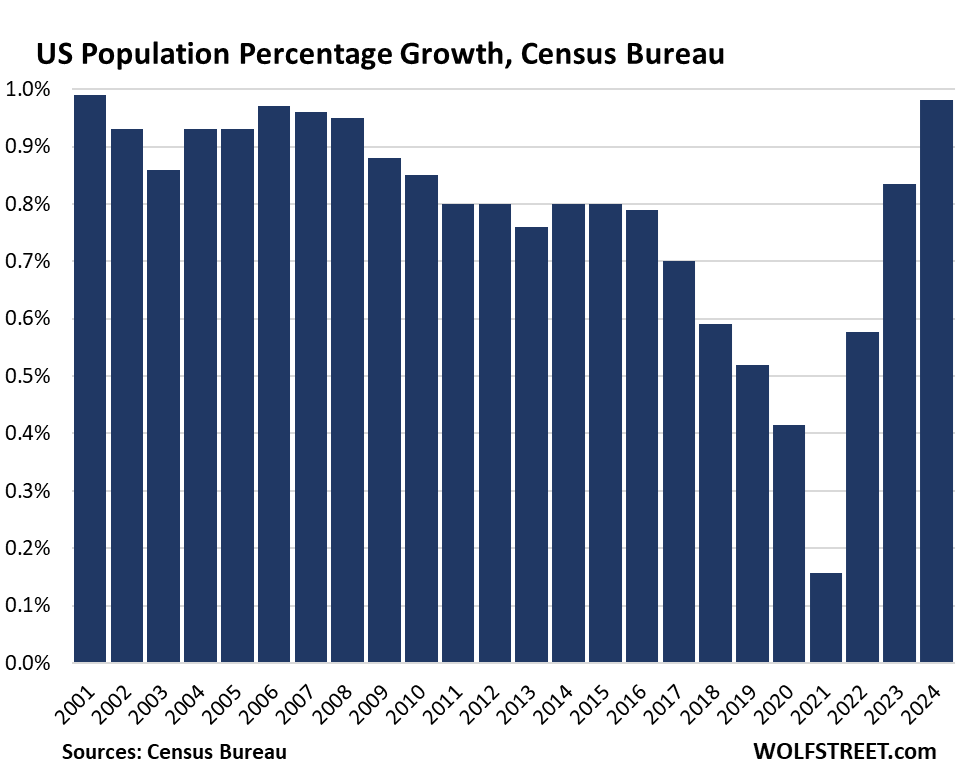In a recent analysis by Wolf Richter for WOLF STREET, the Census Bureau’s updated population estimates released in July 2024 reveal a significantly underestimated surge in immigration over the past few years. The new data indicates that the U.S. population rose by 8 million people from July 2021 to July 2024, now totaling 340.1 million. The largest contributor to this growth was net immigration, which saw a remarkable increase of 2.79 million people in the year leading up to July 2024, marking the highest population growth rate in decades. This surge in immigration was previously underestimated, leaving policymakers, including those at the Federal Reserve, without a clear understanding of labor supply dynamics during a pivotal period on the labor market.
The updated figures show that net immigration accounted for the bulk of the population increase each year, with 1.69 million arrivals in 2022, 2.29 million in 2023, and 2.79 million in 2024. This trend emphasizes the need for improved data collection methods. The Census Bureau indicated that by leveraging newly available administrative data from various government agencies, they have refined their approach to capturing the fluctuations in international migration accurately. This methodological overhaul allows for a much clearer picture of how immigration trends affect the labor pool, ultimately leading to better-informed policymaking and economic planning.
In light of these revisions, significant changes in employment data are anticipated early in 2025 when the Bureau of Labor Statistics (BLS) updates its household survey data to reflect these new population estimates. The BLS’s assessment over the past two years has been clouded by underreporting of the working-age immigrant population. Historically, the total employment figures derived from the household survey are linked to the population data from the Census, yet inaccurate immigration data have hindered precise calculations. The upcoming revisions will likely show a substantial uptick in total employment and labor force statistics, which will provide a clearer understanding of recent labor market developments.
The implications of these data revisions are complex. While it is expected that adjustments will enhance the overall counts of employment and labor force, there may not be a dramatic shift in the unemployment rate. The calculation of the unemployment rate involves dividing the number of unemployed by the total labor force, and since both numbers will increase, the rate itself might remain relatively stable. However, these revisions are expected to restore the historical relationship between total employment and nonfarm payroll data, a relationship that has been disrupted due to the miscalculation of immigrant workers.
Importantly, the Bureau of Labor Statistics does not differentiate between the legal status of workers, which means that any newly arrived immigrants, whether employed or actively seeking work, will be counted in labor force metrics. This inclusivity further demonstrates the significance of these upcoming revisions, which will illuminate the true extent of employment scenarios impacting U.S. economic policy. The disconnection between total employment figures and nonfarm payroll numbers has highlighted divergences in workforce data, and the revised statistics should assist in refining our understanding of the labor market, especially concerning self-employed and agricultural workers who are often underrepresented in traditional payroll reports.
Ultimately, the new data from the Census Bureau signifies a pivotal reevaluation of labor supply in the U.S., necessitating a reassessment of how immigration shapes the economy. As policymakers adapt to these findings, there is an urgent need for ongoing monitoring and statistical refinement to better navigate future labor market trends. The ongoing analysis from WOLF STREET underscores that accurate data is vital to formulating sound economic policy and ensuring that labor market statistics accurately reflect the realities of an increasingly diverse and growing population.

